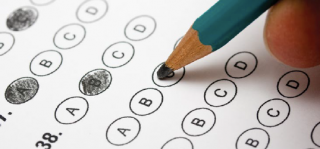
I hate multiple-choice tests. And tests that involve matching, fill in the blanks and all other such silliness. To be honest, I’m not a big fan of tests at all. That’s because tests tend not to be designed with genuine learning in mind. If they were, our tests would look very different. And we would rarely, if ever, use tests of the multiple-choice variety.
So, why do I hate multiple-choice tests? Let me count the ways.
Objection 1: Most Multiple-Choice Tests Tell Us Very Little About What Students Actually "Know"
Teachers give multiple-choice tests in order to find out what students know. But let’s explore this idea a bit. Here is a sample multiple-choice question for a high school class in United States history:
One of the principal reasons the “noble experiment” of Prohibition failed was that it led to an enormous increase in:
(a) Drinking among minors
(b) Absenteeism among factory workers
(c) The divorce rate
(d) Child abuse
(e) Law enforcement costs
Now this seems like a good question. As far as multiple-choice questions go, it is a rather typical one. So, what’s wrong with this?
The main problem is that it requires so little on the part of the student. All the student has to do is to link “prohibition” in some way with “increased law enforcement costs”. What does a correct answer to the question tell us about what the student knows about “Prohibition”? If asked, which of the following might the student say?
- I didn’t really know the answer; I guessed.
- The first four answers don’t seem right, so it’s probably the last one.
- Prohibition increased law enforcement costs.
- I don’t really know about the consequences of prohibition. But I do know that prohibition outlawed alcohol, and that the “experiment” was a failure. If it outlawed alcohol, then there must have been law enforcement costs. So (e) must be the best answer.
- The term “prohibition” is used to refer to an era in American history that followed the ratification of the 18th Amendment to the Constitution. That amendment made it against the law to manufacture, transport or sell “intoxicating liquors”. The 18th Amendment was the result of the temperance movement, which began in the early part of the 19th century as a religious movement devoted to the moral perfection of the American people. This is why “prohibition” is referred to as “the noble experiment”. The 18th Amendment was difficult to enforce, and led to the proliferation of speakeasies, illegal production and trade of alcohol, organized crime and spiraling law enforcement costs. In 1933, Congress passed the 21st Amendment which repealed the 18th Amendment.
Which of these five statements describes what a student who answered correctly on this question "knows" about prohibition? The answer, of course, is that we don’t know. It could be any of the answers. As an assessment of what students know, this question tells us very little.
Let’s ask a different question: What is the minimal knowledge that the student needs in order to get the question right? Well, the minimal knowledge, of course, is knowing that guessing has a chance of producing a correct answer. But let’s not consider that. Besides guessing, the minimum that a student needs to know to answer this question correctly is answer #2 – that is, sensing that the first four answers don’t seem quite right, so the answer must be (e).
Objection 2: Multiple-Choice Tests Often Don’t Require Integration of Knowledge
But wait! Is this what we want our students to know about Prohibition? No! We don’t want our children simply to be able to recognize and answer with minimal knowledge. We want our children to understand relations among ideas. Actually, we don’t even just want our children to be able to understand relations between ideas, but we want them to be able to produce that knowledge – in speech or in writing – when asked. Multiple-choice tests don’t tend to do this. They don’t require that students actively integrate – bring ideas together. And that is what we really want our children to be able to do.
If we asked a student about Prohibition, we want the child to be able to produce for him or herself something like answer (5) above. That is what we mean by knowledge. Knowledge is not simply being able to recognize answers or to make loose connections between ideas. Knowledge refers to the capacity to do something – to explain something; to write about some particular topic or content area; to present specific ideas to others clearly; to bring ideas together to solve a problem or perform some intellectual or practical task. How can this be done?
Objection 3: Students Don’t Learn by Taking (and Preparing for) Multiple-Choice Tests
We learn by doing, and, most often, by doing things with more accomplished others. If you would like to know what a person is learning, find out what she is doing. If a student is taking multiple-choice tests, then he will learn “multiple-choice tests”. If a child is sitting in a lecture listening, she will learn to sit in the lecture and listen. If a person is taking notes from a lecture, her learning will only be as good as what she is able to do with the lecture -- that is, her learning will only be as good as the notes that she is able to take.
Of course, we don’t tend to teach students how to take notes. Note taking is not so much about putting pen to paper as it is a form of active listening. It has more to do with listening and monitoring our comprehension, asking questions to fill the gaps in our understanding and curiosity, and writing down our understanding of what is being said.
Optimally, a test should not simply test. A test should also teach. When students take multiple-choice tests, they don’t tend to learn from the taking of the test. Why is this? Well, given a multiple choice test, where does the learning take place? In the studying, of course. But there are at least two problems here. First, students who are studying for multiple choice tend to be memorizing and not pulling ideas together in an integrative fashion. Second, students tend not to know how to study for tests. We don't teach them! And so, the "learning" that occurs as students study for multiple choice tests occurs in conditions when they are learning (studying) alone, without the benefit of a more accomplished other.
If children (and adults) learn what they do, then the best way to teach is to ask them to do the thing we want them to learn. If we want students to know what Prohibition was, why it came about and why it failed, we must ask them to research this issue; write about it; present and explain it to others; and so forth.
That's why the best learning experiences tend to be guided projects, performed gradually over time, with corrective feedback. When we perform a project, we are forced to bring many forms of knowledge and skills together in one place. When we write, for example, we are forced to identify the ideas we want to write about and bring them together in a way that is understandable to others. When we make a multi- media presentation, we are forced not only to bring ideas together, but the many skills that go into making the presentation itself. That’s real learning.
And that’s real testing too. If we want to test someone, find out what they are able to do. If a person creates a project, the project is their product. The quality of the product reflects the quality of the learning. When we “test” by assessing someone’s product, the test not only tests, it teaches.




